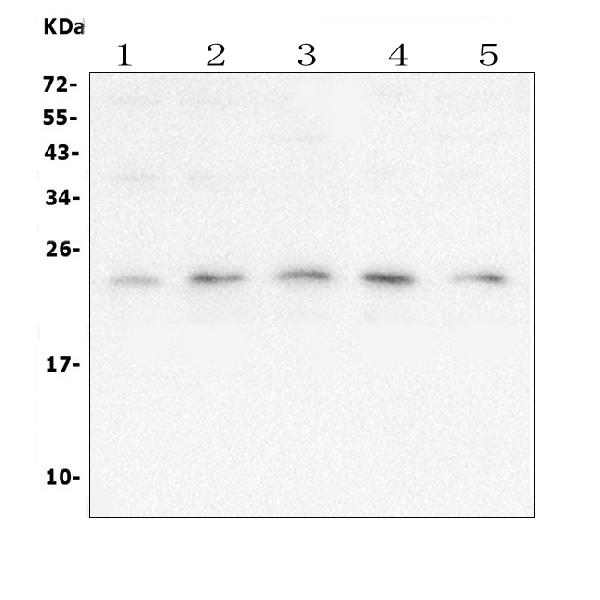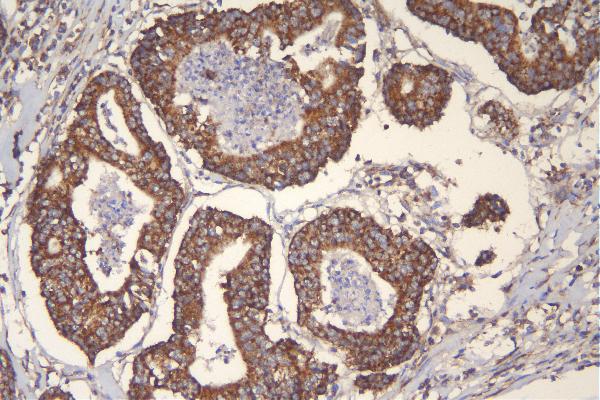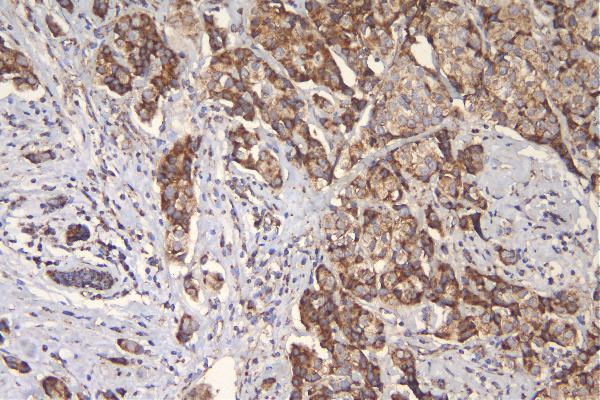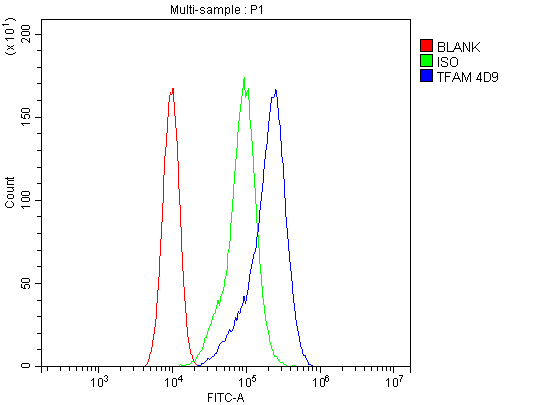| Western blot (WB): | 1:500-2000 |
| Immunohistochemistry (IHC): | 1:50-400 |
| Flow Cytometry (Fixed): | 1:50-200 |
| (Boiling the paraffin sections in 10mM citrate buffer,pH6.0,or PH8.0 EDTA repair liquid for 20 mins is required for the staining of formalin/paraffin sections.) Optimal working dilutions must be determined by end user. | |

Western blot analysis of TFAM using anti-TFAM antibody (M01119-1). The sample well of each lane was loaded with 30 ug of sample under reducing conditions.
Lane 1: human HEK293 tissue lysates,
Lane 2: human K562 whole cell lysates,
Lane 3: human Caco-2 whole cell lysates,
Lane 4: human Raji whole cell lysates,
Lane 5: human A549 whole cell lysates.
After electrophoresis, proteins were transferred to a membrane. Then the membrane was incubated with mouse anti-TFAM antigen affinity purified monoclonal antibody (M01119-1) at a dilution of 1:1000 and probed with a goat anti-mouse IgG-HRP secondary antibody (Catalog # BA1050). The signal is developed using ECL Plus Western Blotting Substrate (Catalog # AR1197). A specific band was detected for TFAM at approximately 24 kDa. The expected band size for TFAM is at 29 kDa.

IHC analysis of TFAM using anti-TFAM antibody (M01119-1).
TFAM was detected in a paraffin-embedded section of human rectum cancer tissue. Biotinylated goat anti-mouse IgG was used as secondary antibody. The tissue section was incubated with mouse anti-TFAM Antibody (M01119-1) at a dilution of 1:200 and developed using Strepavidin-Biotin-Complex (SABC) (Catalog # SA1021) with DAB (Catalog # AR1027) as the chromogen.

IHC analysis of TFAM using anti-TFAM antibody (M01119-1).
TFAM was detected in a paraffin-embedded section of human breast cancer tissue. Biotinylated goat anti-mouse IgG was used as secondary antibody. The tissue section was incubated with mouse anti-TFAM Antibody (M01119-1) at a dilution of 1:200 and developed using Strepavidin-Biotin-Complex (SABC) (Catalog # SA1021) with DAB (Catalog # AR1027) as the chromogen.

Flow cytometry analysis of CACO-2 cell HELA(1:100) Fluoro488 conjugated goat anti-mouse IgG(blue) was used as secondary antibody. Isotype control antibody (Green line) was mouse IgG Fluoro488. Unlabelled sample (Red line).

Western blot analysis of TFAM using anti-TFAM antibody (M01119-1). The sample well of each lane was loaded with 30 ug of sample under reducing conditions.
Lane 1: human HEK293 tissue lysates,
Lane 2: human K562 whole cell lysates,
Lane 3: human Caco-2 whole cell lysates,
Lane 4: human Raji whole cell lysates,
Lane 5: human A549 whole cell lysates.
After electrophoresis, proteins were transferred to a membrane. Then the membrane was incubated with mouse anti-TFAM antigen affinity purified monoclonal antibody (M01119-1) at a dilution of 1:1000 and probed with a goat anti-mouse IgG-HRP secondary antibody (Catalog # BA1050). The signal is developed using ECL Plus Western Blotting Substrate (Catalog # AR1197). A specific band was detected for TFAM at approximately 24 kDa. The expected band size for TFAM is at 29 kDa.

IHC analysis of TFAM using anti-TFAM antibody (M01119-1).
TFAM was detected in a paraffin-embedded section of human rectum cancer tissue. Biotinylated goat anti-mouse IgG was used as secondary antibody. The tissue section was incubated with mouse anti-TFAM Antibody (M01119-1) at a dilution of 1:200 and developed using Strepavidin-Biotin-Complex (SABC) (Catalog # SA1021) with DAB (Catalog # AR1027) as the chromogen.

IHC analysis of TFAM using anti-TFAM antibody (M01119-1).
TFAM was detected in a paraffin-embedded section of human breast cancer tissue. Biotinylated goat anti-mouse IgG was used as secondary antibody. The tissue section was incubated with mouse anti-TFAM Antibody (M01119-1) at a dilution of 1:200 and developed using Strepavidin-Biotin-Complex (SABC) (Catalog # SA1021) with DAB (Catalog # AR1027) as the chromogen.

Flow cytometry analysis of CACO-2 cell HELA(1:100) Fluoro488 conjugated goat anti-mouse IgG(blue) was used as secondary antibody. Isotype control antibody (Green line) was mouse IgG Fluoro488. Unlabelled sample (Red line).



